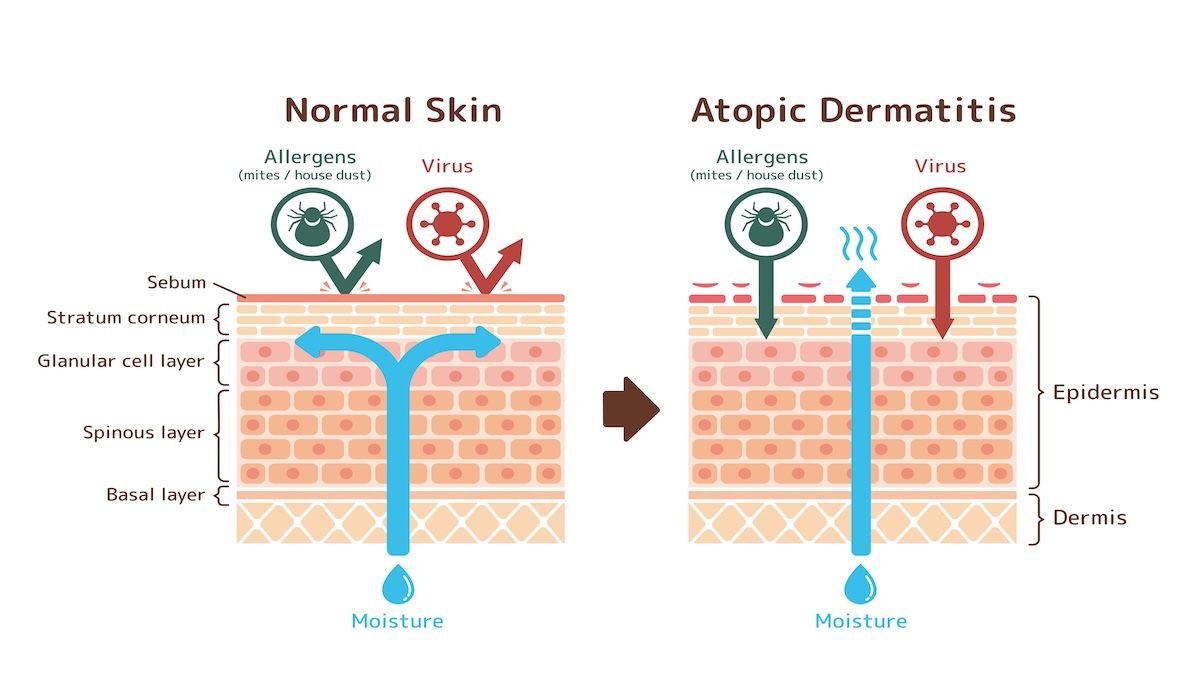- Center on Health Equity & Access
- Clinical
- Health Care Cost
- Health Care Delivery
- Insurance
- Policy
- Technology
- Value-Based Care
Yearly Flares in Atopic Dermatitis May Predict Disease Severity
In this study, total flares were investigated for their propensity to predict atopic dermatitis disease severity among adult patients.
Total yearly flares may be a useful predictive tool for atopic dermatitis disease severity or prognosis, and investigators recommend a threshold amount that can be incorporated into treatment decisions to enhance disease control and patient quality of life (QOL).
These authors published the results from their investigation, which used quantile regression models and boosted random forests to uncover potential correlations between disease burden and impaired QOL and flare frequency, in JAMA Dermatology.1 They also used Dermatology Life Quality Index (DLQI), Patient- Oriented Scoring of Atopic Dermatitis (PO-SCORAD), and Patient-Oriented Eczema Measure (POEM) to gauge disease severity and life impact.
“Despite flaring being frequently reported by patients with [atopic dermatitis],” the authors wrote, “it is not routinely considered in severity classifications or the development of treatment guidelines.”
There were 878 patients overall in this study, which used data from 2 surveys administered by the Danish Skin Cohort: January 14, 2022, to February 6, 2022, and January 3 to 31, 2023. Their median (IQR) age was 49 years (39-59), median age at diagnosis was 2 years (1-8), 68.2% were female patients, 48.8% had comorbid asthma, 66.7% had comorbid allergic rhinitis, 58.2% lived a low-sedentary lifestyle, 59.1% had a family history of atopic dermatitis, and 83.2% were currently receiving treatment and either very satisfied (26.5%), somewhat satisfied (25.1%), or neither satisfied nor dissatisfied (15.0%). The patients were divided into 4 groups, based on yearly flares: 0 (n = 26), 1 to 5 (n = 405), 6 to 10 (n = 169), and more than 10 (n = 278).
Median current, worst in the past 12 months, and worst ever body surface area reported in 2023 rose in correlation with total flares reported for 2022, study authors reported. | Image Credit: © barks-stock.adobe.com

Overall, the most common mean flare duration was between 1 and 7 days, at 35.2% of the 1-to-5 flare cohort, 39.9% of the 6-to-10 flare cohort, and 43.8% of the above-10 flare cohort, and the baseline median rating of the severity of the latest flare was 5 (3-7), 5 (4-7), and 6 (5-8) in the 1-to-5, 6-to-10, and above-10 flares cohorts, respectively. Most patients had moderate (65.5%) or severe (32.2%) atopic dermatitis. For those for whom data were available from the 2022 and 2023 surveys, 71.4% of patients with 0 flares, 27.5% with 1 to 5 flares, and 28.8% with 6 to 10 flares switched to a group with more frequent flares in 2023.
Median current, worst in the past 12 months, and worst ever body surface area reported in 2023 rose in correlation with total flares reported for 2022. For instance, median (IQR) current body surface areas were as follows in 2023:
- 2 (1-5) among patients with 0 flares in 2022
- 5 (2-10) among patients with 1 to 5 flares in 2022
- 5 (3-10.5) among patients with 6 to 10 flares in 2022
- 8 (3-20) among patients with more than 10 flares in 2022
Per results seen using POEM, atopic dermatitis severity ranged from 4.5 (2.0-9.8) in patients reporting no flares in 2022 to 13 (8-18) in patients reporting more than 10 flares (quantile regression coefficient, 0.29; 95% CI, 0.20-0.38), indicating a correlation. Using PO-SCORAD, there was a significant correlation (regression coefficient, 0.11; 95% CI, 0.03-0.19). Life impairment according to the DLQI was also greater with higher total flares: 5.0 (2.0-8.8) for patients with more than 10 yearly flares in 2022 compared with 2.0 (1.0-5.0) for patients with 1 to 5 yearly flares; this remained significant after considering sex and age (quantile regression coefficient, 0.15; 95% CI, 0.11-0.20).
When the authors used a logistic regression model, higher odds were seen for having moderate (OR, 1.06; 95% CI, 1.03-1.09) and severe (OR, 1.11; 95% CI, 1.08-1.15) atopic dermatitis vs mild; however, for patients with more flares, they had lower odds of increasing even 1 severity category (OR, 0.90; 95% CI, 0.82-0.99), “which may be explained by the already high number of flares and a potential ceiling effect,” the authors wrote.
Using binary prediction, family history and sex were the weakest predictors of patients transforming from mild/moderate to moderate/severe atopic dermatitis, and flare severity and total flares in 2022 were the strongest predictors of more severe disease. For prediction of annual flares, total flares in the previous year and atopic dermatitis severity per PO-SCORAD and POEM were the strongest predictors, and again, family history of atopic dermatitis and sex were the weakest predictors.
The authors explain that their findings suggest regardless of flare severity, total flares account for what affects disease severity and the most significant reductions in patient QOL, with their overall strengths being how they echo previous analyses of the Danish Skin Cohort2,3 and a third analysis that saw links between flare type/frequency and predictors of patient-perceived burden of disease.
Still, they caution, “although the models presented in this article serve as an exploratory tool to validate the predictability of flares and disease severity and quantify the importance and predictive power of different variables, rigorous development and extensive testing are necessary prior to implementation in clinical settings.”
References
- Nielsen ML, Nymand LK, Domenech P, et al. Predictors of flares and disease severity in patients with atopic dermatitis using machine learning. JAMA Dermatol. 202516:e252073. doi:10.1001/jamadermatol.2025.2073
- Nymand L, Nielsen M-L, Vittrup I, et al. Atopic dermatitis phenotypes based on cluster analysis of the Danish Skin Cohort. Br J Dermatol. 2024;190(2):207-215. doi:10.1093/bjd/ljad401
- Nielsen M-L, Nymand LK, Domenech Pena A, et al. Characterization of patients with atopic dermatitis based on flare patterns and severity of disease: a Danish population-based study. J Eur Acad Dermatol Venereol. 2025;39(2):301-307. doi:10.1111/jdv.20160
